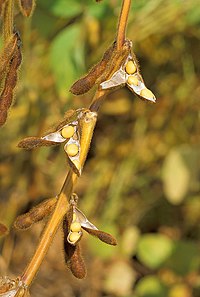
Photo from wikipedia
The aim of this study was to investigate the extraction of soybean oil using ethanol under pressurized conditions. The effects of pressure (10 and 20 MPa), temperature (30 to 90 °C) and… Click to show full abstract
The aim of this study was to investigate the extraction of soybean oil using ethanol under pressurized conditions. The effects of pressure (10 and 20 MPa), temperature (30 to 90 °C) and solvent flow (1 and 3 mL/min) were evaluated applying different extraction times. In addition, the thermodynamics parameters of the process were determined. It was observed that the pressure exerted no influence on the extraction kinetics, while an increase in temperature promoted better yields. The use of the highest solvent flow increased the initial extraction rate, but did not influence the yield under equilibrium conditions. Based on the thermodynamic parameters, the extraction was classified as endothermic (44.11 kJ/mol), irreversible (143.52 J/mol K) and partially spontaneous (0.60 to −8.01 kJ/mol), and an increase in the temperature favoured this spontaneity. Extraction using the classical Soxhlet method was evaluated for comparison purposes using ethanol and n-hexane as solvents and ethanol showed a better extraction efficiency. The maximum yield obtained with pressurized liquid extraction (PLE) was 24.42%, which represents ∼94% of the yield obtained by classical extraction. Linoleic and oleic acids were the main fatty acids identified in the soybean oil, representing ∼76% of the fatty acids composition, which was not influenced by the extraction method or the temperature used in the PLE. This article is protected by copyright. All rights reserved
Journal Title: Canadian Journal of Chemical Engineering
Year Published: 2017
Link to full text (if available)
Share on Social Media: Sign Up to like & get
recommendations!